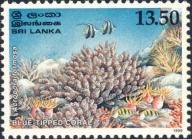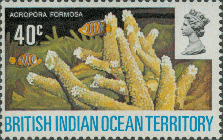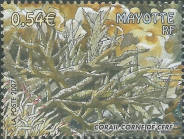
| About | | Search taxa | | Taxon tree | | Search literature | | Checklist | | Stats | | Log in |
WoRMS name detailsAcropora formosa (Dana, 1846)
207036 (urn:lsid:marinespecies.org:taxname:207036)
unaccepted > junior subjective synonym
Species
marine,
(of Madrepora formosa Dana, 1846) Dana, J.D. (1846-1849). Zoophytes. United States Exploring Expedition during the years 1838-1842. <em>Lea and Blanchard, Philadelphia.</em> 7: 1-740, 61 pls. (1846: 1-120, 709-720; 1848: 121-708, 721-740; 1849: atlas pls. 1-61)., available online at http://www.sil.si.edu/digitalcollections/usexex/navigation/ScientificText/USExEx19_08select.cfm [details]
Note Fiji and Sulu Sea (Veron, 1986).
From other sources
Type locality Fiji and Sulu Sea (Veron, 1986). [details]
Description This species forms extensive thickets like Acropora horrida, and can extend across many square metres of loose and sandy...
Description This species forms extensive thickets like Acropora horrida, and can extend across many square metres of loose and sandy substrate. Branch surfaces are even and fairly regular. Radial corallites are not ragged; they are tubular and may occur in two sizes. Tentacles are not seen during the daytime. Acropora formosa is mainly found in shallow, lagoonal areas without strong wave action (Sheppard, 1998). Colonies are arborescent, usually forming thickets. Radial corallites may be similar or varied in size, and uniformly or erratically distributed. Colour: usually cream, brown or blue, usually with pale branch ends. Abundance: very common and frequently the dominant species of lagoons and some fringing reef (Veron, 1986). Forms dense thickets up to 1.5 m high, easily broken by anchors and storms. It is conspicuous and fast-growing (branches may extend 2-6 cm per year) and clearly demonstrates the staghorn shape of may Acropora species. Colour: usually dark grey or brown, with pale pink, purple or blue growing tips. Habitat: maybe dominant in lagoons and sheltered reefs with substantial water movement (Richmond, 1997). [details] Distribution Central Indo-Pacific to Japan
Distribution Central Indo-Pacific to Japan [details]
Hoeksema, B. W.; Cairns, S. (2024). World List of Scleractinia. Acropora formosa (Dana, 1846). Accessed through: World Register of Marine Species at: https://www.marinespecies.org/aphia.php?p=taxdetails&id=207036 on 2024-07-26
Date action by 2000-09-28 07:24:50Z changed Garcia, Maria
original description
(of Madrepora formosa Dana, 1846) Dana, J.D. (1846-1849). Zoophytes. United States Exploring Expedition during the years 1838-1842. <em>Lea and Blanchard, Philadelphia.</em> 7: 1-740, 61 pls. (1846: 1-120, 709-720; 1848: 121-708, 721-740; 1849: atlas pls. 1-61)., available online at http://www.sil.si.edu/digitalcollections/usexex/navigation/ScientificText/USExEx19_08select.cfm [details]
basis of record Veron JEN. (1986). Corals of Australia and the Indo-Pacific. <em>Angus & Robertson Publishers.</em> [details] additional source Sheppard CRC. (1987). Coral species of the Indian Ocean and adjacent seas: a synonymised compilation and some regional distribution patterns. <em>Atoll Research Bulletin.</em> 307: 1-32., available online at http:// https://doi.org/10.5479/si.00775630.307.1 [details] additional source Hoffmeister, J.E. (1925). Some corals from America Samoa and the Fiji Islands. <em>Papers from the Department of Marine Biology of the Carnegie Institution of Washington.</em> 22: 1-90, pls. 1-23. page(s): 55-57, Pl. 8, fig. 1 [details] additional source Cairns, S.D., B.W. Hoeksema & J. van der Land. (1999). Appendix: List of extant stony corals. <em>Atoll Research Bulletin.</em> 459: 13-46. page(s): 15 [details] additional source Wallace CC. (1999). Staghorn corals of the world: a revision of the coral genus Acropora (Scleractinia; Astrocoeniina; Acroporidae) worldwide, with emphasis on morphology, phylogeny and biogeography. CSIRO, Collingwood (Australia). pp i-xvii, 1-421. [details] additional source Steiner, S.C.C., 2003. Stony corals and reefs of Dominica. Atoll Res. Bull. : 497-508. page(s): 4, 8, 9 [details] additional source Cairns, S.D., B.W. Hoeksema & J. van der Land. (2007). as a contribution to UNESCO-IOC Register of Marine Organisms. (look up in IMIS) [details] additional source Liu, J.Y. [Ruiyu] (ed.). (2008). Checklist of marine biota of China seas. <em>China Science Press.</em> 1267 pp. (look up in IMIS) [details] Available for editors additional source Wells JW. (1955). Recent and subfossil corals of Moreton Bay, Queensland. <em>Queensland. University of Queensland Papers, Department of Geology.</em> 4 (10): 1-18, pls. 1-3. page(s): 5, 7, 9 [details] additional source Scheer G, Pillai CSG. (1974). Report on Scleractinia from the Nicobar Islands. <em>Zoologica, Stuttgart.</em> 42(122): 1-75. page(s): 7, 16-17, 18, 75 [details] additional source Nemenzo, F. (1967). Systematic studies on Philippine shallow-water scleractinians. VI Suborder Astrocoeniina (Montipora and Acropora). (Part I - Text; Part II - Plates). <em>Natural and Applied Science Bulletin, University of the Philippines.</em> 20: 1-141, 143-223. page(s): 4, 49, 61, 184, Pl. XXI [details] additional source Pillai CSG, Scheer G (1976) Report on the stony corals from the Maldive Archipelago. Results of the Xarifa Expedition 1957/58. Zoologica, Stuttgart 43 (126): 1-83, pls. 1-32. [details] additional source Crossland C (1952) Madreporaria, Hydrocorallinae, Heliopora and Tubipora. Scientific Report Great Barrier Reef Expedition 1928-29 VI(3): 85-257. page(s): 100 [details] additional source Verrill AE. (1902). Notes on corals of the genus Acropora (Madrepora Lam.) with new descriptions and figures of types, and of several new species. <em>Transactions of the Connecticut Academy of Arts and Sciences.</em> 11: 207-266, pls. 36, 36A-F. page(s): 215 [details] additional source Veron JEN, Marsh LM. (1988). Hermatypic corals of Western Australia : records and annotated species list. <em>Records Western Australian Museum Supplement.</em> 29: 1-136., available online at https://doi.org/10.5962/bhl.title.60555 page(s): 25, 52 [details] additional source Pillai CSG. (1972). Stony corals of the seas around India. <em>Proceedings of the First International Symposium on Corals and Coral Reefs, 1969. Marine Biological Association of India Symposium.</em> 5: 191-216. page(s): 198 [details] additional source Utinomi, H. (1965). A revised catalogue of scleractinian corals from the southwest coast of Shikoku in the collections of the Ehime University and the Ehime Prefectural Museum, Matsuyama. <em>Publications of the Seto Marine Biological Laboratory.</em> 13(3): 243-261., available online at https://doi.org/10.5134/175404 page(s): 247 [details] additional source Randall RH, Myers RF. (1983). The corals. Guide to the Coastal Resources of Guam: Vol. 2. <em>University of Guam Press, Guam, pp. 128.</em> [details] additional source Wallace CC. (1978). The coral genus Acropora (Scleractinia: Astrocoeniina: Acroporidae) in the central and southern Great Barrier Reef Province. <em>Memoirs of the Queensland Museum.</em> 18(2): 273-319, pls. 43-103. [details] additional source Veron, J. E. N. (2000). Corals of the World, Volume I: Family Acroporidae. Australian Institute of Marine Science. Townsville., volume 1, pp. 463. page(s): 204-205 [details] additional source Maragos, J. E.; Molina, M.; Kenyon, J. (2004). Palmyra Atoll coral data compiled from Townsend Cromwell 2000-2002, U.S. Fish and Wildlife Service 2000-2001, and Sette 2004 surveys [Table 8]. UNPUBLISHED, UNPUBLISHED [details] additional source Maragos, J. E.; Schmerfeld, J. (2004). Coral survey from Howland Island National Wildlife Refuge, 1998-2004 [Table 3]. UNPUBLISHED, Unpublished page(s): 1 [details] additional source Maragos, J. E. (2004). Baker Island coral data [Table unnumbered]. UNPUBLISHED, Unpublished page(s): 1 [details] additional source Wells JW. (1954). Recent corals of the Marshall Islands: Bikini and nearby atolls, part 2, oceanography (biologic). <em>U.S. Geological Survey Professional Paper.</em> 260(I): 385-486. page(s): 390, 400, 401, 403, 405, 415, 417, 418, pls. 102, 103, 104 [details] additional source Pillai CSG. (1983). Structure and generic diversity of recent Scleractinia of India. <em>Journal of the Marine Biological Association of India.</em> 25, 1-2, 78-90. page(s): 84 [details] additional source Sheppard, C. R. C. (1985). Fringing reefs in the southern region, Jeddah to Jizan. Fauna of Saudi Arabia, 7, 37-58 page(s): 45, 51 [details] additional source Reimer, J. D.; Ono, S.; Furushima, Y.; Tsukahara, J. (2007). Seasonal changes in morphological condition of symbiotic dinoflagellates (Symbiodinium spp.) in Zoanthus sansibaricus (Anthozoa: Hexacorallia) in southern Japan. South Pacific Sudies, 27(2): 1-23 page(s): 2 [details] additional source Kuguru, B. L.; Mgaya, Y. D.; Öhman, M. C.; Wagner, G. M. (2004). The reef environment and competitive success in the Corallimorpharia. Marine Biology, 145, 875-884 page(s): 875, 877, 879 [details] additional source Verde, E. A.; McCloskey, L. R. (2007). A comparative analysis of the photobiology of zooxanthellae and zoochlorellae symbiotic with the temperate clonal anemone Anthopleura elegantissima (Brandt). III. Seasonal effects of natural light and temperature on photosynthesis and respiration. Marine Biology, 152, 775-792 page(s): 787 [details] additional source Kühlmann, D. H. H. (2006). Die Steinkorallensammlung im Naturhistorischen Museum in Rudolstadt (Thüringen) nebst ökologischen Bemerkungen. Rudolstädter Naturhistorische Schriften, 13, 37-113 page(s): 61, 70, 111 [details] additional source Tkachenko, K. S.; Wu, B. J.; Fang, L. S.; Fan, T. Y. (2007). Dynamics of a coral reef community after mass mortality of branching Acropora corals and an outbreak of anemones. Marine Biology, 151, 185-194 page(s): 188, 189 [details]  Present Present  Present in aphia/obis/gbif/idigbio Present in aphia/obis/gbif/idigbio  Inaccurate Inaccurate  Introduced: alien Introduced: alien  Containing type locality Containing type locality
Nontype HLD X2: 127-7, geounit Indian Exclusive Economic Zone [details]
Nontype HLD X2: 127-8, geounit Indian Exclusive Economic Zone [details]
Nontype MSI C-1115, geounit Philippines Exclusive Economic Zone [details]
Nontype MSI C-267, geounit Philippines Exclusive Economic Zone [details]
Nontype MSI C-733, geounit Philippines Exclusive Economic Zone [details]
Nontype MSI C-736, geounit Philippines Exclusive Economic Zone [details]
Nontype NMSR 8503, geounit Yemeni Exclusive Economic Zone [details]
Nontype NMSR K 62 [details]
Nontype NMSR K 63 [details]
Nontype WAM 142-73, geounit Australian Exclusive Economic Zone [details]
Nontype WAM 166-74, geounit Australian Exclusive Economic Zone [details]
Nontype WAM 213-74, geounit Australian Exclusive Economic Zone [details]
Nontype WAM 244-87, geounit Australian Exclusive Economic Zone [details]
Nontype WAM 350-84, geounit Australian Exclusive Economic Zone [details]
Nontype WAM 414-84, geounit Australian Exclusive Economic Zone [details]
Nontype WAM 473-78, geounit Australian Exclusive Economic Zone [details]
Nontype WAM 520-86, geounit Ashmore-Cartier Is. [details]
Nontype WAM 544-81, geounit Australian Exclusive Economic Zone [details]
Nontype WAM 683-85, geounit Australian Exclusive Economic Zone [details]
Nontype WAM 698-85, geounit Australian Exclusive Economic Zone [details]
Nontype WAM 699-85, geounit Australian Exclusive Economic Zone [details]
Nontype WAM 700-85 [details]
Nontype WAM 700-85, geounit Australian Exclusive Economic Zone [details]
Nontype WAM 701-85, geounit Australian Exclusive Economic Zone [details]
Nontype WAM 705-85, geounit Australian Exclusive Economic Zone [details]
Nontype WAM 706-85, geounit Australian Exclusive Economic Zone [details]
Nontype WAM 708-85, geounit Australian Exclusive Economic Zone [details]
Nontype WAM 718-85, geounit Australian Exclusive Economic Zone [details]
Nontype WAM 721-86, geounit Ashmore-Cartier Is. [details]
Nontype WAM 727-81, geounit Australian Exclusive Economic Zone [details]
Nontype WAM 75-72, geounit Australian Exclusive Economic Zone [details]
Nontype WAM 77-73, geounit Australian Exclusive Economic Zone [details]
Nontype WAM 778-85, geounit Australian Exclusive Economic Zone [details]
Nontype WAM 787-85, geounit Australian Exclusive Economic Zone [details]
Nontype WAM 792-85, geounit Australian Exclusive Economic Zone [details]
Nontype WAM 89-73, geounit Australian Exclusive Economic Zone [details]
Unknown type USNM, geounit Marshall Islands Exclusive Economic Zone [details]
From other sources
Biology zooxanthellate [details]Description This species forms extensive thickets like Acropora horrida, and can extend across many square metres of loose and sandy substrate. Branch surfaces are even and fairly regular. Radial corallites are not ragged; they are tubular and may occur in two sizes. Tentacles are not seen during the daytime. Acropora formosa is mainly found in shallow, lagoonal areas without strong wave action (Sheppard, 1998). Colonies are arborescent, usually forming thickets. Radial corallites may be similar or varied in size, and uniformly or erratically distributed. Colour: usually cream, brown or blue, usually with pale branch ends. Abundance: very common and frequently the dominant species of lagoons and some fringing reef (Veron, 1986). Forms dense thickets up to 1.5 m high, easily broken by anchors and storms. It is conspicuous and fast-growing (branches may extend 2-6 cm per year) and clearly demonstrates the staghorn shape of may Acropora species. Colour: usually dark grey or brown, with pale pink, purple or blue growing tips. Habitat: maybe dominant in lagoons and sheltered reefs with substantial water movement (Richmond, 1997). [details] Distribution Central Indo-Pacific to Japan [details] Type locality Fiji and Sulu Sea (Veron, 1986). [details]
To Barcode of Life (2 barcodes)
To Biodiversity Heritage Library (28 publications) To Biological Information System for Marine Life (BISMaL) To European Nucleotide Archive, ENA (Acropora formosa) To GenBank (32 nucleotides; 26 proteins) To IUCN Red List (Near Threatened) To USNM Invertebrate Zoology Cnidaria Collection (60 records) To ITIS |



